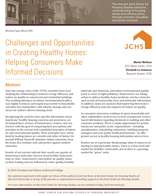Challenges and Opportunities in Creating Healthy Homes: Helping Consumers Make Informed Decisions
Information about Americans' healthy housing concerns, including principles of indoor air and environmental quality, and surveys analyzing perceptions of homeowners, renters, and contractors.
Since the energy crises of the 1970s, scientists have been studying the relationship(s) between energy efficiency and indoor air quality in commercial and residential buildings. The resulting literature on indoor environmental health is vast, highly technical, and largely inaccessible to households and other key stakeholders who inhabit, manage and construct our nation's diverse housing stock.
Recognizing the need for more specific information about Americans' healthy housing concerns and awareness, we developed three surveys of homeowners, renters, and contractors with the goal of comparing their perceptions and priorities to the current well-established principles of indoor air and environmental quality. These principles were articulated by leading indoor air scientist and editor of Indoor Air Journal William Nazaroff: minimize indoor emissions, keep the home dry, ventilate well, and protect against outdoor emissions.
Results of our surveys indicate that: nearly one quarter of homeowners had some concern about healthy-home problems or risks; homeowners cited indoor air quality issues as their leading concern, followed by water quality, harmful materials and chemicals, and indoor environmental quality (such as noise or light pollution). Homeowners are taking action to address healthy-home problems, but face obstacles such as lack of trustworthy, clear, and actionable information. In addition, many are unaware that improving their home's energy efficiency may also improve its indoor air quality.
As consumer awareness continues to grow, households and other stakeholders need access to more transparent, science-based information regarding chemicals in building and other consumer products. There is ample opportunity for private businesses and public sector organizations—including manufacturers, remodeling contractors, building/property managers and even public health professionals—to offer greater access to healthy housing information and services.
Renters are at a particular disadvantage when it comes to obtaining/occupying healthy homes. There is a clear need and market for healthier rental units, just as there is a growing market for "green" units.
--
Read Mariel Wolfson's accompanying blog post: Three Things We Need To Do To Develop a Healthy Housing Stock

